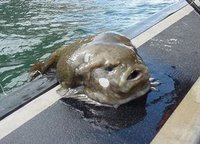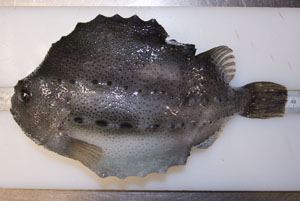
Cyclopterus lumpus
FAMILY
Cyclopteridae
TAXONOMY
Cyclopterus lumpus Linnaeus, 1758, Baltic Sea and North Sea.
OTHER COMMON NAMES
English: Henfish, lumpsucker; French: Grosse poule de mer.
PHYSICAL CHARACTERISTICS
Thick body with rows of hard, conical tubercles, and with a soft,
cartilaginous hump on the back, embedding the first dorsal fin.
The tubercles are in a single row along the back and in three
lateral rows on each side. Pelvic fins are modified into a suction
disc. The fish is green, gray, blue, or brown, with red highlights
on breeding males. Breeding females become distended with
eggs. Lumpfishes have reached 2 ft (61 cm) and 21 lb (9.5 kg).
DISTRIBUTION
Across the North Atlantic Ocean from Chesapeake Bay to
Hudson Bay, Greenland, Iceland, the White Sea, and south
through the British Isles to France.
HABITAT
This is a bottom fish that inhabits cold waters on rock bottom.
Early in life the hatchlings, fully formed as juveniles, are in
surface waters, then older juveniles are semipelagic, living under
seaweed.
BEHAVIOR
From the time of hatching, lumpfishes are capable of using
their pelvic sucking disc to adhere to smooth surfaces, which
tend first to be seaweed blades, then rocks.
FEEDING ECOLOGY AND DIET
Crustacean plankton like krill, amphipods, and copepods, as
well as jellyfishes and small fishes.
REPRODUCTIVE BIOLOGY
Early in spring the lumpfish female deposits an adhesive egg
mass of over 100,000 eggs on rocky bottom among seaweed.
Lumpfishes spawn more than one batch of eggs, and hatching
occurs from May to July, after six to ten weeks of incubation.
Egg color is polymorphic between different females, including
colors like brown, red, pink, orange, yellow, green, and purple.
CONSERVATION STATUS
Not listed by the IUCN. Early accounts listed the lumpfish as
being of no economic value, but they were always a bycatch in
the inshore cod trap and gillnet fishery, and their ripe eggs
were marketed as caviar starting in the late 1960s. In North
America the flesh is sold as dog food, but it is eaten by people
in Europe. The eggs are stripped from ripe females and packed
in brine for preparation as lumpfish caviar.
Overfishing has occurred. In Newfoundland the catch rate
was 229 lb (104 kg) per net per year in 1979 (total landings 85
tonnes) at 16 nets per boat, whereas by 1996 the catch rate was
down to 21 lb (9.5 kg) per net per year (total landings still 82
tonnes) at 40 nets per boat, and nearly ten times as many boats
in the same region.
SIGNIFICANCE TO HUMANS
With the decline of beluga sturgeon and other traditional
sources of caviar, lumpfish caviar has become highly valued.
Photo Gallery of - Lumpfish





 Animalia Life
Animalia Life